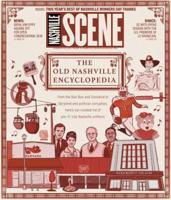I went over to Fort Negley to see if I could learn more about the old Catholic cemetery (earlier post here). They were super helpful. They have an old map that clearly showed where the old Catholic cemetery was — in what is now the bend of the railroad, right off the back of the parking lot for Greer Stadium — and they have a giant picture of the area around Fort Negley on the wall of the visitor's center which shows the Catholic cemetery. You might need one of the Fort Negley employees to point it out for you, but, when you locate the headstones in the picture, you'll see the ones on the other side of the railroad tracks — the city cemetery — but, lo, there in front of the train tracks are more headstones — the old Catholic cemetery.
So, that's pretty cool. There's still a photo of it.
I went out and gave the old cemetery a look, but there's nothing to see, really. The part that might have been under the back parking lot is, well, now under a parking lot. The overgrown parts are overgrown. The land, what I could make out of it behind the fence and under the local flora, was wildly uneven and declined rather steeply toward the tracks. Clearly, that ground has been through a lot of upheaval since the cemetery was there.
Then, our friends at the Tennessee State Library and Archives — unofficial motto: "You thought that was cool? Look at what else we have" — sent me a link to this hand-drawn map of Nashville during the Civil War. Fair warning, the map is two pages and that first page will suck you in! We had a distillery?! Look at all those creeks! It's really neat.
On the second page, between Nolensville Pike and Franklin Road, along the Chattanooga rail line, you see clearly the "old grave yard," which is the still-present city cemetery, and the "new grave yard," which appears to be the old Catholic cemetery. What this tells us foremost is that the cemetery was drastically altered by the arrival of the curve in the train tracks and that much of the old Catholic cemetery land is now the railroad's.
When I was at Fort Negley, I was trying to get a feel for what the war would have meant for the Catholic cemetery. Two things struck me. One, African American refugees would have probably been camped in the cemetery. The need for relatively flat ground in that area makes it likely that people would have been in the relatively flat cemetery. But also, the folks who work at Fort Negley explained to me that my understanding of the thousands of Civil War soldiers buried in the Nashville city cemetery was too simplistic.
It turns out that Civil War dead were brought up and down that railroad line and dropped right there in the shadow of Fort Negley to be dealt with. Of course they didn't all fit in the City Cemetery. If you've been there, you know it's big, but it's not "thousands of dead people at once" big. So, where did those dead soldiers go?
You can probably guess, but let's let our friends at the TSLA explain it, since they set out to track every Civil War burial in Nashville:
The Federal Army employed W. R. Cornelius, a local undertaker, to bury Confederate and Federal soldiers. All available land was used within the City Cemetery. Then the Federal Army authorized the purchase of additional acres adjoining the City Cemetery. These additions were known as the Due West and Southwest cemeteries.
If that Due West Cemetery didn't include the old Catholic Cemetery, I'll eat my hat. The Southwest Cemetery was probably on the south side of Chestnut.
This adds a great deal of important context to our current understanding of why so many prominent Nashville families moved their loved ones' remains out to Mt. Olivet or even why Mt. Olivet came to exist in the first place (and similarly with the old Catholic Cemetery and Calvary). It wasn't simply that these older cemeteries became "unfashionable," it was that they were huge open wounds on the city — in constant, high-volume use during the war, dug back up to move remains into the proper cemeteries after the war, filled with refugees, and the smell. My god, could you imagine what that part of town must have smelled like? And certainly, the burial of random, probably mostly non-Catholic soldiers on hallowed ground would have been theologically distressing to the Catholics in town.
Anyway, to bring us full circle, when I initially discovered the existence of the old Catholic cemetery, I was intrigued by the suggestion that not all Catholics made it out of the old cemetery into Calvary. Turns out, that was true but that the Catholic church rectified that in 1902. On February 17th, the Nashville Banner reported that the old Catholic cemetery was being officially abandoned (emphasis mine).
Bishop Byrne yesterday issued an order for the removal of all the dead in the old Catholic Cemetery adjoining the City Cemetery, to Mt. Calvary. Those having lots in the old cemetery will be given in exchange a lot at Mt. Calvary, and graves will be exchanged in the same way. Relatives will remove their own dead and bury on their own lots in Mt. Calvary, if they own one, but all unknown dead will be removed by the church.
So, there we have it. All the dead Catholics in the old Catholic cemetery did make their way to Calvary, eventually. But these efforts to track that down have led me to realize that the Civil War probably played a greater roll in the abandoning of this cemetery and the plummet in popularity of the City Cemetery than we know.




